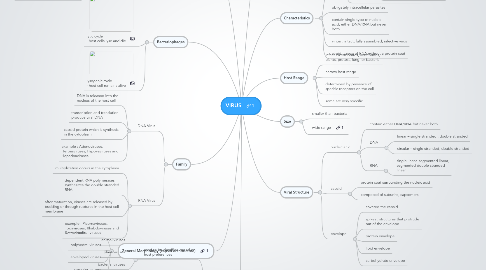
1. Family
1.1. DNA Virus
1.1.1. DNA is released into the nucleus of the host cell
1.1.2. transcription and translation produce viral DNA
1.1.3. capsid protein which is synthesis in the cytoplasm
1.1.4. example : Adenoviruses, Herpesviruses, Papovaviruses and Hepadnaviruses
1.2. RNA Virus
1.2.1. multiplication occurs in the cytoplasm
1.2.2. dependent RNA polymerases synthesizes the double stranded RNA
1.2.3. after maturation, viruses are released by budding or through ruptures in the host cell membrane
1.2.4. example : Picornaviruses, Togaviruses, Rhabdoviruses and Retroviruses
2. General Morphology (capsid architecture)
2.1. helical viruses
2.2. polyhedral viruses
2.3. enveloped viruses
2.4. complex viruses
3. Taxonomy
3.1. used to be classified based on host preferences
3.1.1. animal viruses
3.1.2. plant viruses
3.1.3. bacterial viruses
3.2. International Commitee for Taxonomy of Virus (ICTV)
3.2.1. nucleic acid type
3.2.2. nucleic acid strandedness
3.2.3. the sense (+ve/-ve) of single stranded RNA
3.2.4. presence/absence of envelope
3.2.5. type of host
3.3. names of viruses
3.3.1. family : ends with viridae
3.3.2. subfamily : ends with virinae
3.3.3. genus and sp. : virus
3.4. characteristics to divide viruses into taxonomic groups
3.4.1. nature of host
3.4.2. nucleic acid characteristics
3.4.3. capsid symmetry
3.4.4. presence of envelope
3.4.5. diameter of the virion or nucleocapsid
3.4.6. number of capsomers in icosahedral viruses
3.4.7. type of virus release
3.4.7.1. with/without tails
3.4.7.2. with/without envelope
3.4.8. presence/absence DNA intermediate
4. Bacteriophages
4.1. lytic cycle - host cells lyse and die
4.2. lysogenic cycle - host cell remains alive
5. Isolation and Cultivation
5.1. growth of bacteriophages
5.1.1. plaque method : mix bacteriophages with host bacteria and nutrient agar
5.2. quantifying viruses
5.2.1. plaque assay : the number of plaque directly relates to numbers of infectious virus particles applied to the plate
5.3. growth of animal viruses
5.3.1. in living animal hosts
5.3.2. in embryonated eggs
5.3.3. in cell cultures
5.4. viral infections
5.4.1. infection by individual human viral pathogens
5.4.2. patterns of viral infection or disease - latent - persistent
6. Characteristics
6.1. smaller than bacteria
6.1.1. not retained by bacterial filters
6.1.2. not visible in the light microscope
6.2. obligately intracellular parasites
6.3. contain single type of nucleic acid, either DNA/RNA but never both
6.4. virion : intact, fully assembled, infective virus
6.5. viroid : piece of RNA without a protein coat
7. Host Range
7.1. infect invertebrates, vertebrates, plants, protest, fungi or bacteria
7.2. narrow host range
7.3. determined by presence of specific receptors on the cell
7.4. some are very specific
8. Size
8.1. smaller than bacteria
8.2. wide range
9. Viral Structure
9.1. nucleic acid
9.1.1. contain either DNA/RNA but never both
9.1.2. DNA
9.1.2.1. linear – single stranded , double stranded
9.1.2.2. circular – single stranded, double stranded
9.1.3. RNA
9.1.3.1. single linear, segmented linear, segmented double stranded linear
9.2. capsid
9.2.1. protein coat surrounding the nucleic acid
9.2.2. composed of subunits, capsomers
9.3. envelope
9.3.1. covered the capsid
9.3.2. spikes : structures that protrude out of the envelope
9.3.3. protein envelope
9.3.4. lipid envelope
9.3.5. carbohydrate envelope
10. Viruslike Agents
10.1. viroids
10.1.1. an infectious RNA particle smaller than a virus
10.1.2. plant infected
10.1.3. differ from viruses in six ways
10.1.3.1. consists of a single circular RNA molecule of molecular weight
10.1.3.2. exist inside cells as particles
10.1.3.3. do not require a helper virus
10.1.3.4. does not produce proteins
10.1.3.5. copied in the host cell nucleus
10.1.3.6. viroid particles are not apparent in infected tissue without the use of special techniques
10.2. prions
10.2.1. resistant to inactivation by heating to 90 degree celcious
10.2.2. not sensitive to radiation treatment
10.2.3. sensitive to protein denaturing agents
